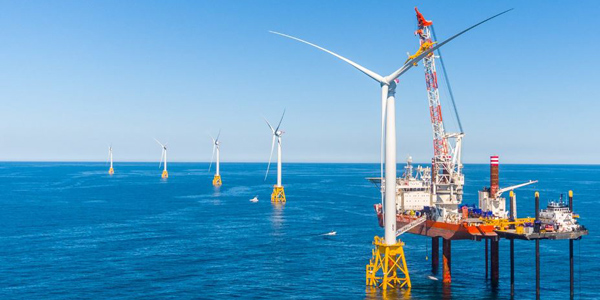By Michael Kuser
A new plan released by the New York State Energy Research and Development Authority on Monday details how the state plans to develop 2,400 MW of offshore wind by 2030.
But a separate policy paper by the same agency outlines the challenges in meeting that goal — including the limited amount of transmission available to interconnect offshore wind during the program’s initial solicitations for 800 MW of capacity over the next couple years.
The state’s master plan projects that the full deployment of offshore turbines by 2030 would reduce greenhouse gas emissions by more than 5 million short tons, or approximately one-third the expected reductions from new renewable energy projects developed to meet the 50% renewable electricity target under the state’s Clean Energy Standard. (See New York Seeks to Lead US in Offshore Wind.)
“While the federal government continues to turn its back on protecting natural resources and plots to open up our coastline to drilling, New York is doubling down on our commitment to renewable energy and the industries of tomorrow,” Gov. Andrew Cuomo said.
Lisa Dix, New York senior representative for the Sierra Club, said the master plan “shows that a commitment to a steady stream of projects over the next decade” will create thousands of jobs while increasing the state’s economic.
“But the state must act swiftly this year to issue a procurement and establish an enforceable long-term program, with a guarantee projects are built every year, the governor’s targets are met and the climate, economic, manufacturing and jobs benefits are realized,” she said.
In a Jan. 29 filing with the Public Service Commission, NYSERDA detailed how the wind energy areas available to compete for offshore wind procurements in 2018 and 2019 “are limited, dispersed and not readily expandable.”
The agency said that an expandable “backbone” transmission system would offer the benefit of economies of scale and reduced barriers to entry, but it could also lead to overbuilding and stranded asset costs. A transmission system custom-built for a single offshore facility, the “direct radial” model, costs more and is limited in scope.
The real limit, however, is the industry’s nascent stage of growth. The federal government has so far leased only one area off New York City, the April 2017 lease to Statoil, which is capable of hosting approximately 1,000 MW. However, the policy paper said that wind projects off Rhode Island, Massachusetts and New Jersey could conceivably interconnect directly to New York or interconnect within an adjacent control area with energy delivered to NYISO, which would make them eligible for procurement under the Clean Energy Standard.
“Offshore wind developers are ready to help New York meet the governor’s goals, and are particularly interested in when and how they can compete for contracts and invest in New York,” Anne Reynolds, director of the Alliance for Clean Energy New York, said in a statement. “The Offshore Wind Policy Options Paper lays out these procurement options. Nailing down these procurement details needs to be New York’s next step.”
Market Approaches
NYSERDA assumes that offshore wind deployments will be funded through a purchase obligation placed on load-serving entities and that procurement will be conducted through separate offshore wind solicitations, using a similar competitive process to that used for large-scale renewables under the state’s Renewable Energy Standard Tier 1 procurements.
The agency offered several market-based approaches to procurement, including fixed renewable energy credits, bundled power purchase agreements, utility-owned generation and split PPAs. It also floated three varieties of offshore wind RECs (ORECs): market, index and forward.
For procurements during the first phase of the offshore wind program, NYSERDA expects ORECs to be more expensive than RECs sourced from other Tier 1 projects because of the higher capital costs for offshore. And while the fixed REC process is well-established, the price premium for offshore RECs could leave the agency financially exposed because it would act as the central procuring agency for the certificates.
“To the extent that this premium would not be addressed through co-incentives, NYSERDA’s blended REC price would increase — likely significantly — compared to its REC resale price without offshore wind,” NYSERDA said. As a result, the agency might not be able to recover its costs through the sale of RECs and resort to the utility “backstop” funding obligation of the CES. The risk would be exacerbated by a fall in power prices.
How LSEs Could Pay
NYSERDA also said the PSC could employ an allocation mechanism that set LSE compliance obligation levels according to actual production from offshore wind projects. Like New York’s zero-emission credits, these ORECs would be non-tradable and allocated to LSEs based on load.
The NYSERDA paper concluded that “under the allocation structure, the design of the dedicated offshore wind obligation could be set to achieve a much greater match between REC supply and target. Perfect alignment between REC supply and target could be achieved by setting the target for each period upon conclusion of the period to match exactly the available offshore wind REC volume.”
While that approach would address NYSERDA’s exposure to REC price differentials, it would foreclose the possibility of developing spot market price signals for ORECs, the agency acknowledged. Still, it did not consider that a big drawback given that offshore projects are not likely to respond to market signals for a long time because of their risk profiles.
NYSERDA will host two public webinars Feb. 13 to provide an overview of the Offshore Wind Master Plan and the next steps that New York will take to develop offshore wind.



